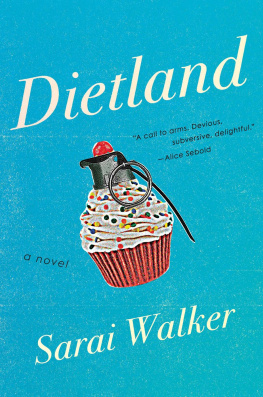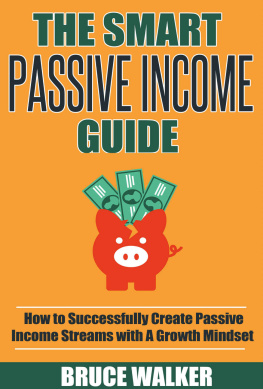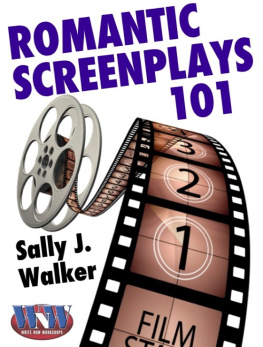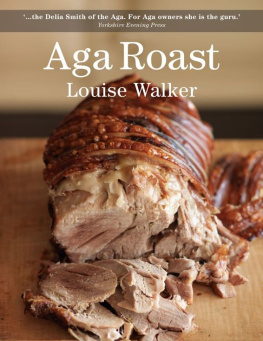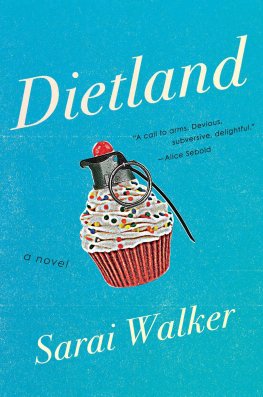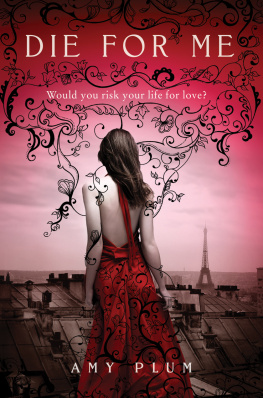Copyright 2015 by Sarai Walker
All rights reserved
For information about permission to reproduce selections from this book, write to Permissions, Houghton Mifflin Harcourt Publishing Company, 215 Park Avenue South, New York, New York 10003.
www.hmhco.com
The Library of Congress has cataloged the print edition as follows:
Walker, Sarai.
Dietland / Sarai Walker.
pages cm
ISBN 978-0-544-37343-3 (hardback)
1. ObesitySurgeryFiction. 2. FeministsFiction. I. Title.
PS3623.A3595595D54 2015
813'.6dc23
2014026803
Book design by Greta D. Sibley
eBook design by Katie Coaster
Jacket design and illustration by Laserghost
Jacket illustration based on cupcake photograph Kelly Cline/Getty Images
e ISBN 978-0-544-37344-0
v2.0815
This is a work of fiction. Names, characters, places, organizations, and events are products of the authors imagination or are used fictitiously.
To my parents,
for believing in me
and to my foremothers,
who didnt always have a voice
She waited for a few minutes to see if she was going to shrink any further: she felt a little nervous about this; for it might end, you know, said Alice to herself, in my going out altogether, like a candle. I wonder what I should be like then?
Lewis Carroll,
Alices Adventures in Wonderland
RABBIT HOLE
IT WAS LATE IN THE SPRING when I noticed that a girl was following me, nearly the end of May, a month that means perhaps or might be. She crept into the edges of my consciousness like something blurry coming into focus. She was an odd girl, tramping around in black boots with the laces undone, her legs covered in bright fruit-hued tights, like the colors in a roll of Life Savers. I didnt know why she was following me. People stared at me wherever I went, but this was different. To the girl I was not an object of ridicule but a creature of interest. She would observe me and then write things in her red spiral-bound notebook.
The first time I noticed the girl in a conscious way was at the caf. On most days I did my work there, sitting at a table in the back with my laptop, responding to messages from teenage girls. Dear Kitty, I have stretch marks on my boobs, please help. There was never any end to the messages and I usually sat at my table for hours, sipping cups of coffee and peppermint tea as I gave out the advice I wasnt qualified to give. For three years the caf had been my world. I couldnt face working at home, trapped in my apartment all day with nothing to distract me from the drumbeat of Dear Kitty,Dear Kitty, please help me.
One afternoon I looked up from a message I was typing and saw the girl sitting at a table nearby, restlessly tapping her lime green leg, her canvas bag slouched in the chair across from her. I realized that Id seen her before. Shed been sitting on the stoop of my building that morning. She had long dark hair and I remembered how she turned to look at me. Our eyes met and it was this look that I would remember in the months to come, when her face was in the newspapers and on TVthe glance over the shoulder, the eyes peeking out from the thick black liner that framed them.
After I noticed her at the caf that day, I began to see her in other places. When I emerged from my Waist Watchers meeting, the girl was across the street, leaning against a tree. At the supermarket I spotted her reading the nutrition label on a can of navy beans. I made my way around the cramped aisles of Key Food, down the canyons of colorful cardboard and tin, and the girl trailed me, tossing random things into her shopping basket (cinnamon, lighter fluid) whenever I turned to look at her.
I was used to being stared at, but that was by people who looked at me with disgust as I went about my business in the neighborhood. They didnt study me closely, not like this girl did. I spent most of my time trying to blend in, which wasnt easy, but with the girl following me it was like someone had pulled the covers off my bed, leaving me in my underpants, shivering and exposed.
Walking home one evening, I could sense that the girl was behind me, so I turned to face her. Are you following me?
She removed tiny white buds from her ears. Im sorry? I didnt hear you. I had never heard her speak before. I had expected a flimsy voice, but what I heard was a confident tone.
Are you following me? I asked again, not as bold as the first time.
Am I following you? The girl looked amused. Im afraid I dont know what youre talking about. She brushed past me and continued on down the sidewalk, being careful not to trip on the tree roots that had burst through the concrete.
As I watched the girl walk away, I didnt yet see her for who she was: a messenger from another world, come to wake me from my sleep.
WHEN I THINK OF MY LIFE at that time, back then, I imagine looking down on it as if it were contained in a box, like a dioramathere are the neighborhood streets and I am a figurine dressed in black. My daily activities kept me within a five-block radius and had done so for years: I moved between my apartment, the caf, Waist Watchers. My life had narrow parameters, which is how I preferred it. I saw myself as an outline then, waiting to be filled in.
From the outside, to someone like the girl, I might have seemed sad, but I wasnt. Each day I took thirty milligrams of the antidepressant Y. I had taken Y since my senior year of college. That year there had been a situation with a boy. In the weeks after the Christmas break I slipped into a dark spiral, spending most of my time in the library, pretending to study. The library was on the seventh floor and I stood at the window one afternoon and imagined jumping out of it and landing in the snow, where it wouldnt hurt as much. A librarian saw melater I found out I had been cryingand she called the campus doctor. Soon after that pharmaceuticals became inevitable. My mother flew to Vermont. She and Dr. Willoughby (an old gray man, with gray hair, tinted glasses, a discolored front tooth) decided it was best for me to see a therapist and take Y. The medication took away my sadness and replaced it with something elsenot happiness, but more like a low dull hum, a weak radio frequency of feeling that couldnt be turned up or down.
Long after college ended, and the therapy ended, and Id moved to New York, I continued to take Y. I lived in an apartment on Swann Street in Brooklyn, on the second floor of a brownstone. It was a long and skinny place that stretched from the front of the building to the back, with polished blond floorboards and a bay window that overlooked the street at the front. Such an apartment, on a coveted block, was beyond my means, but my mothers cousin Jeremy owned it and reduced the rent for me. He would have let me live there rent free if my mother hadnt nosed in and demanded I pay something, but what I paid was a small amount. Jeremy worked as a reporter for the Wall Street Journal. After his wife died he was desperate to leave New York and especially Brooklyn, the borough of his unhappiness. His bosses sent him to Buenos Aires, then Cairo. There were two bedrooms in the apartment and one of them was filled with his things, but it didnt seem as if he would ever come back for them.
There were few visitors to the apartment on Swann Street. My mother came to see me once a year. My friend Carmen visited sometimes, but I mostly saw her at the caf. In my real life I would have more friends, and dinner parties and overnight guests, but my life wasnt real yet.
The day after my confrontation with the girl, I looked up and down the street but I didnt see her, so I set off, relieved not to be followed. A day of work at the caf awaited me, but first I would stop at my Waist Watchers meeting, taking the long route so I could bypass the boys who congregated at the end of my block and often made rude comments.
Next page
